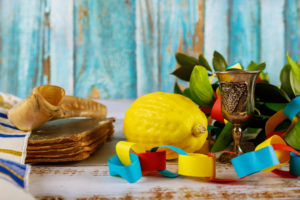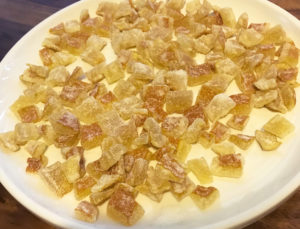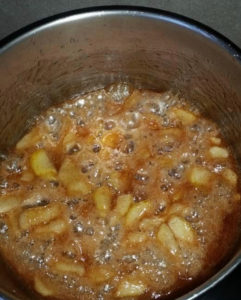Consider the etrog.

A citrus fruit with a lemony floral scent, it is one of the “Four Species of Sukkot,” taken in hand and shaken together in the central ritual of the ancient holiday.
The etrog can be viewed as a treasure that can nourish us, lift our spirits and contribute to our religious observance beyond Sukkot. Its advocates say it is full of flavor, aroma, symbolism, religious significance and therapeutic benefits.
But its yellow peel covers an interior that is mostly thick rind with a small center that is full of seeds. It is not juicy.
Even so, it’s a shame to spend $50 on a fruit that comes all the way from Israel, and toss it out after a week.
These days, traditional ways to use etrogim post-Sukkot take their place alongside new ones. Judaism teaches us not be wasteful. We can use etrogim from the Sukkot celebration.
The weeklong Sukkot holiday commemorates God’s protection of the Israelites during their desert wanderings. It is also a harvest festival from later times when the people had settled in the land of Israel.
Sukkot are the booths (singular: sukkah) that scripture says the Israelites dwelled in in the desert. In the land of Israel, they were the field dwellings used during the fall harvest. Sukkot is a season of joy, a holiday of gratitude. The Jewish Thanksgiving.
Israeli-born chef Michael Solomonov, known for his restaurants in Philadelphia and beyond, recalls the etrog and other three species — the lulav, comprising the date palm, the willow and the myrtle.
“I remember eating etrog jam after Sukkot,” he says. “We are a very big citrus family, and we like lemon a lot. I was always obsessed with this idea of making lemonade or water ice – Italian water ice – with the etrog, which is not a strength of the etrog.”
He describes making the culinary most of the etrog’s unique attributes — the fruity citrus, the floral, the bitter, the sour. And doing it without overwhelming the flavor.
The bitter and sour aspects of the etrog mean “you can go very heavy with the sweet. Things like dried fruit, dates in particular, go so well,” he says, noting, “It also goes well with savory food.”
The upshot: “I think it is extremely versatile and extremely underused.”
Solomonov likes to slice an etrog into very thin wheels or half-moons and pickle the slices.
“If you were to take candied or pickled etrog stuffed inside of a date with toasted almond, and warm it up, you would have something incredibly special,” he says.
The etrog can be used to make a rice dish by “steaming rice in coconut milk with etrog zest and poppy seed, for example. That would be fantastic,” he says.
Or create a dish of chicken liver with preserved etrog, pomegranate and dates. Preserved etrog would work well with raw fish, and it can be served as a garnish on gravalax, he says.
A dessert that would let the etrog shine: candied etrog slices atop vanilla cake, Solomonov says.
Candied etrog and etrog soda
Recipes for etrog jams and for citrus fruit marmalades dot the Internet.

Food preservation dates back thousands of years. Cultures continually added methods suitable to preserve their foods, and food preservation was a necessity, notably to stay fed in cold winters.
Citrons — the etrog is a citron — are “traced to Southeast Asia and Chinese river valleys,” says Jon Greenberg, a teacher and biblical and talmudic ethnobotanist in New Jersey, whose organization, Torah Flora, specializes in plants and nature in the Torah and Jewish tradition.
Archaeologists have found evidence of the etrog outside Jerusalem, dating back 2,500 years ago, he says.
The archaeologists were excavating a palace garden in what is now Ramat Rachel and discovered etrog pollen in the walls. The layer of plaster dated from the time of the Jewish return from exile in Babylonia around 538 B.C.E.
Greenberg says the word “etrog, does not appear in the Bible. It is a Farsi, or Persian, word, which suggests the etrog was a foreign import.
Sugar, used to sweeten etrog jam, make homemade flavored vodka and brandy (often opened on Tu B’Shevat and Purim) and other etrog products, became available during the Renaissance. Native to Asia, sugar didn’t become widespread in the West until after the late 18th century. Even then, it was used more as a flavoring, Greenberg says. The homemade jam at the time was sauce-like.
Only in modern times, when food stores began selling commercially processed foods — commercial kosher jams showed up on shelves the late 1800s — were such products widely available in the Jewish community, Greenberg says.
Abram Herman owns and operates The Sukkah Project®, a year-round family business in Grand Junction, Colorado, that sells sukkahs and holiday-related items. Herman, who likes to cook, says he tinkered with etrog recipes, making changes to suit his taste.
Among his efforts, he makes candied etrogim. They taste a little lemony, he says — “like an etrog smells. It’s got these floral notes.”
He saves the syrup he pours off during the candy-making process. “You end up with complex simple syrup,” Herman says.
With it he makes etrog soda. It’s better when the syrup is added to water and a carbonation device is used to create the fizz, he says. But mixing the syrup and club soda is good, too
His other uses for the syrup: drizzled over ice cream, added to a fruit parfait, to sweeten iced tea and to add the etrog’s unique citrus-floral flavor to alcoholic drinks.
The pregnancy-etrog connection
The etrog is called the fruit of the beautiful tree. It is joined in the holiday ritual by the lulav, a cluster of plants: a palm branch, two boughs of willow and three boughs of myrtle.

In Rockville, Riki Alkoby, co-owner of Oh Mama Grill, is known locally for her etrog jam.
“People are already asking me about it,” she says.
As sure as Sukkot follows Yom Kippur, etrogim will be handed to her and etrog jam will emerge from her kitchen.
“They say, ‘Oh wow, if you make it this year, let me know,’ because apparently if you give some to someone who is pregnant or wants to be pregnant, it helps them.”
The pregnancy-etrog connection is an old one. A look through online sources shows centuries of stories and anecdotes linking etrogim to pregnancy and easier childbirth — and that includes in modern times.
Did eating Alkoby’s etrog jam help women seeking to become pregnant? She says has received feedback that some women who ate it did become pregnant.
“If it works, you feel like you are doing something for someone else. Even if it does not work, you give them hope.”
Shattered Citron
An online search for etrog uses returns hits in the six figures.

Not all uses for etrogim are about eating or drinking it. There are numerous craft and aromatherapy uses. Health and medicinal benefits have been attributed to the etrog — which in the plant world is Citrus Medica — including aiding fertility and providing inflammation relief. It’s been used in perfume for centuries. Soaps and skin-care products also are available.
Devorah Brous, a Los Angeles-area urban homesteader, herbalist and Jewish educator, says that using an etrog for the holiday and then throwing it out runs counter to bal tashchit, Judaism’s teaching that tells us not to be wasteful or destructive.
Brous, whose business is From Soil 2 Soul, says the etrog is a “symbol of bounty and wellness and abundance” — symbolic of produce gleaned during the harvest. And etrogim can be composted, feeding the land that feeds us.
In addition, she says, “there are many other things we could be doing with it if you think about the bounty and not the beauty.”
For religious use, the etrog must be unblemished and come from a tree that has not been grafted.
Brous cautions post-Sukkot etrog users to be mindful of pesticide use on etrogim because it can be heavy. She recommends that for botanical, skin care and herbal medicines, users should thoroughly scrub the fruit or use organic etrogim.
“My sense is that there is an enormous amount we have to learn about the medicinal properties of the etrog,” Brous says, listing a number of reported medicinal uses that include combating nausea and aiding the digestive tract.
She calls the fragrance of the etrog “refreshing,” and uses it alone and with other aromas.
Brous likes to make the most of the citrus-floral aroma of the etrog peel, which she combines with aromatic herbs and/or other citruses to create an air freshener.
Dried peel can be used in candlemaking, she says, noting that etrog peels can be steeped in water, the mixture strained and the liquid used to scent bathwater.
Rabbi Steven Suson, of Congregation Har Tzeon-Agudath Achim in Silver Spring, says he has used an etrog year-round as part of the Havdalah ceremony that ends Shabbat and begins the week.
“We poke whole cloves in it,” he says. “It smells really delicious. We use it for the spices on Saturday night.”
Studding an etrog with cloves is a generations-old practice in some Jewish families.
When etrogim get old, they don’t rot. They get hard. Suson has saved a number of them without cloves. “Now they are like little rocks,” he said.
Sadly, a clove-studded etrog that Suson was using for Havdalah dropped and shattered. A replacement may be forthcoming this year.
How to make etrog jam

Etrog jam is traditional use of etrogim after Sukkot, though recipes vary. Riki Alkoby said this much-enjoyed recipe is typical of those used by many Israelis. The cooked etrogim and the sugar should weigh the same, so be prepared to make adjustments.
Makes about 20 small containers of jam.
Ingredients
- 7 or 8 whole yellow etrogim
- 1 lb. of sugar, approximately, could be more or less.
- 2 sticks of cinnamon
- 1 or 2 cloves
- Juice, freshly squeezed, from ½ lemon
- Water
Directions
- Wash the outside of the etrogim very well. Cover them with water and refrigerate them for 24 hours.
- Remove the etrogim. Cut off the hard top and bottom of each, then remove the seeds. Discard tops, bottoms and seeds. Chop etrogim into small pieces.
- Place the pieces in a pot and cover them with water. Boil them, then drain. Repeat for a total of four boils. This removes some of the bitterness.
- Weigh the mixture. Add the same weight in sugar, and stir it in. Add cinnamon sticks, cloves and lemon juice, then mix well.
- Place the mixture in a pot. Cook the mixture on low heat, stirring occasionally, for about an hour or until it thickens into the consistency of jam. Remove the cinnamon and cloves.
- Place about two spoonfuls in about 20 small containers, refrigerate, and give it away for people to eat soon, as Alkoby does. If you are keeping it, place the hot jam in sterilized jars. It will be eaten up in short order, but will keep for several months in the refrigerator.
– Andrea F. Siegel







